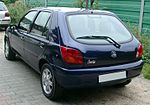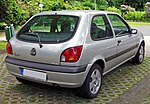Ford Fiesta '96
| Ford Fiesta '96 / '99 | |
|---|---|
| Production period: | 1995-2001 |
| Class : | Small car |
| Body versions : | Station wagon , limousine , panel van |
| Previous model: | Ford Fiesta '89 |
| Successor: | Ford Fiesta '02 |
The Ford Fiesta '96 is the fourth series of the Ford Fiesta . Although the Ford Fiesta '99 is unofficially considered an independent fifth series, the models are closely related. They share the codes for the body shape - including JBS and JAS for three and five-door sedans - the platform and a large part of the technology. Most of the changes affect the shape of the headlights, grille, hood, and the front and rear aprons. In other markets, the Fiesta '99 is not viewed as an independent model, which is why there may be differences in the counting of the series from 1999 onwards.
Fiesta '96 (1995-1999)
| Fiesta '96 | |
|---|---|
|
Ford Fiesta five-door (1995-1999) |
|
| Production period: | 08 / 1995-09 / 1999 |
| Engines: |
Otto engines : 1.25–1.4 liters (37–66 kW) Diesel engines : 1.8 liters (44 kW) |
| Length: | 3828 mm |
| Width: | 1634 mm |
| Height: | 1334 mm |
| Wheelbase : | 2445 mm |
| Empty weight : | 1005-1051 kg |
| Stars in the Euro NCAP - Crash Test |
|
Model history
After seven years, the Fiesta '96 replaced its predecessor. The floor pan was carried over almost unchanged from the Fiesta '89, but the new model was given a completely new shape and also brought many technical improvements. The model name for the three-door was JBS , that for the five-door JAS .
The basic engine was the 1.3-liter petrol engine with 37 kW or 44 kW and electronic injection from the previous model, which was first used as a Kent engine (with carburettor) in 1959 in the Ford Anglia . The two variants were the same except for the throttle valve, which is why it was often replaced as a "tuning measure". New to the Fiesta was the Zetec SE engine, optionally with a displacement of 1.25 liters and 55 kW (75 hp) or with a displacement of 1.4 liters and 66 kW (90 hp). In this light and compact engine, the crankcase and cylinder head were made of aluminum , the valve cover of magnesium . The only diesel engine was the 1.8 liter engine already used in the Escort and Mondeo . In the Fiesta without a turbocharger, it only produced 44 kW.
As with its predecessor, the Fiesta was offered as a Courier with truck and passenger vehicle registration until the end of construction. In 1996/97 there was a Europe-wide recall campaign of 315,000 Fiesta and Fiesta Courier due to faults in the braking system.
The third generation of the Mazda 121 was a Fiesta '96 built in the Ford factory in Cologne with some Mazda- specific modifications.
On the basis of the fourth Fiesta series, the small car Ford Ka was offered from autumn 1996 and the Ford Puma sports coupe from spring 1997 .
In other markets (South America, China etc.) the Fiesta '96 was offered with a 1.0-liter engine and also as a notchback version.
Facelift
In September 1999, a heavily revised version of the Fiesta '96 was presented. Above all, the front of the vehicle was changed with new headlights, a new radiator grille and a new bonnet as well as the front and rear bumpers. Although the type code (JAS / JBS) remained the same, the "Facelift" is an independent, fifth model. In other markets such as B. the UK , both vehicles are considered to be one model.
Equipment lines
- Fiesta Focus
- Fiesta flair
- Fiesta fun
- Fiesta Ghia
Special models
- Fiesta GT
- Fiesta Style "Kool"
- Fiesta Style "Family"
- Fiesta Style "Sport"
Technical specifications
see Fiesta '99:
Fiesta '99 (1999-2001)
| Fiesta '99 | |
|---|---|
|
Ford Fiesta five-door (1999-2001) |
|
| Production period: | 09/1999–11/2001 |
| Engines: |
Petrol engines : 1.3–1.6 liters (37–76 kW) Diesel engines : 1.8 liters (44–55 kW) |
| Length: | 3833 mm |
| Width: | 1634 mm |
| Height: | 1334 mm |
| Wheelbase : | 2446 mm |
| Empty weight : | 930-1015 kg |
| Stars in the Euro NCAP - Crash Test |
|
Model history
The Fiesta '99 was a revised version with a redesigned front section and modified front and rear bumpers. Despite the same type code JAS or JBS, the model is considered the fifth series in Germany and some other countries, while in other markets it is referred to as the facelift of the fourth model generation. From now on, the Fiesta was equipped as standard with 14-inch wheels, internally ventilated disc brakes at the front, side airbags and a third brake light. From spring 2000, the Fiesta Sport was also available with a Zetec SE engine with 1.6 liter displacement and 76 kW (103 hp), 15-inch alloy wheels, rocker panel, grille , round fog lights, special racing blue color and special interior fittings. Also from the year of construction 2000 - although the facelift was only presented shortly before - some technical details on the vehicle were changed. For example, the diameter of the brake discs on the front axle has been increased from 239 to 258 mm.
The engine variants were expanded to include the 1.8-liter diesel engine with turbocharger and direct injection ; the 1.4-liter gasoline engine was no longer available. The 1.6-liter Zetec-SE was only available in the Fiesta Sport from spring 2000 .
The third generation of the Mazda 121 received the same modifications, but not the 1.6-liter gasoline engine.
There was also a panel van variant of this model called Courier .
Equipment lines
- Fiesta
- Fiesta trend
- Fiesta Ghia
- Fiesta sport
Special models
- Fiesta Florida
- Fiesta Futura 2
- Fiesta Kool
Ford Ikon
In India, the Ford Ikon was developed in a joint venture with Mahindra & Mahindra Limited and manufactured for some Asian countries from the beginning of 2000 to spring 2011. It is a notchback sedan based on the Fiesta '99, which was also offered in Brazil , South Africa , Argentina , Mexico and China. For South America, the Ikon was built next to the Fiesta Courier in Brazil.
Derived from the Ikon, the Fiesta Van was produced until 2006 - a three-door model without rear side windows and rear seats, which was not available in Europe. A two-door pickup truck was built in Brazil based on the Fiesta Courier. In South Africa, in addition to the Ikon, a four-door pickup of the Ikon was produced, similar to the Škoda Felicia Vanplus.
Technical specifications
| Gasoline engine | diesel | ||||||
|---|---|---|---|---|---|---|---|
| 1.3 i (1995-2001) |
1.25 i 16V (1995-2001) |
1.4 i 16V (1996–1999) |
1.6 i 16V (1999-2001) |
1.8 D (1995-2000) |
1.8 Tue (2000-2001) |
||
| Engine: | 4-cylinder in-line engine (four-stroke) | ||||||
| Engine type: | Endura-E | Zetec-SE | Endura-DE | Endura-DI | |||
| Displacement: | 1299 cc | 1242 cc | 1388 cc | 1596 cc | 1753 cc | ||
| Bore × stroke: | 74 x 75.5 mm | 71.9 x 76.5 mm | 76 × 76.5 mm | 78.5 x 81.4 mm | 82.5 × 82 mm | ||
| Performance at 1 / min: |
37 kW (50 hp) 4500 |
44 kW (60 PS) 5000 |
55 kW (75 PS) 5200 |
66 kW (90 PS) 6000 |
76 kW (103 PS) 6000 |
44 kW (60 hp) 4800 |
55 kW (75 PS) 4000 |
| Max. Torque at 1 / min: |
94 Nm 2500 |
103 Nm 2500 |
110 Nm 4000 |
125 Nm 4000 |
145 Nm 4000 |
105 Nm 2500 |
140 Nm 1900 |
| Mixture preparation: | Electronic injection | Diesel injection pump | Diesel injection pump Garrett turbocharger |
||||
| Valve control: |
OHV (camshaft in engine block, bumpers, mechanical valve lifters, overhead valves, timing chain) |
DOHC (toothed belt, two overhead camshafts, bucket tappets, overhead valves) |
OHC , timing belt | ||||
| Cooling: | Water cooling | ||||||
| Transmission: | 5-speed gearbox (1.25i aW with continuously variable CTX automatic) |
||||||
| Front suspension: | MacPherson struts , wishbones, coil springs | ||||||
| Rear suspension: | Twist beam axle , coil springs | ||||||
| Body: | Sheet steel, self-supporting | ||||||
| Track width front / rear: | 1429/1373 mm | ||||||
| Wheelbase: | 2445 mm | ||||||
| Length: | 3828 mm | ||||||
| Empty weight: | 930-1015 kg | ||||||
| Top speed: | 143-153 km / h | 170 km / h | 182 km / h | 187 km / h | 155 km / h | 168 km / h | |
| Acceleration 0-100 km / h: |
15.9-19.5 s | 12.7 s | 10.8 s | 10.2 s | 17.4 s | 14.3 s | |
| Consumption (liters / 100 kilometers): | 6.4 S | 6.4-6.7 S. | 6.5 p | 7.8 S | 5.7D | 5.0 D | |
Motorsport
Unlike the three previous models, Ford did not have any motorsport activities for either the Fiesta '96 or the Fiesta '99. The new brand cup and thus the successor to the Ladies Cup and the Mixed Cup was the Puma Cup . At the time, the Puma stood on the platform of the Ford Fiesta, but it was visually the much sportier vehicle. Nevertheless, some privately used Ford Fiesta found their way into motorsport. In particular, Fiesta Sport of the '99 model, which was factory-fitted with the 1.6-liter Zetec SE engine that was also used in the Puma Cup, regularly took part in DTC races in the class up to 1600 cm³.
literature
- Ford-Werke Cologne: Ford moves - 75 years of Ford in Germany . Delius Klasing Verlag, Bielefeld 2000, ISBN 3-7688-1239-1 .
- Stefan Rossbach: Ford: passenger cars since 1945 (type compass) . Motorbuch-Verlag, 2007, ISBN 978-3-613-02692-6 .
Web links
- Official website of the Ford Fiesta
- Link catalog on the topic of Ford Fiesta at curlie.org (formerly DMOZ )
Individual evidence
- ↑ Ford Fiesta. www.euroncap.com, accessed September 28, 2012 .
- ↑ Ford Fiesta. www.euroncap.com, accessed September 28, 2012 .












